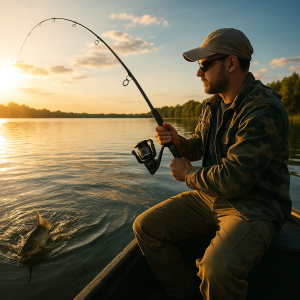Explore the fascinating world of fishing — from traditional techniques to modern industrial applications, sustainability trends, and career opportunities.

🌊 🎣Why Fishing Still Matters Today
Did you know that more than 3 billion people rely on seafood as their primary source of protein? 🌍
Fishing isn’t just about catching fish — it’s about feeding nations, preserving traditions, and driving technological innovation in the maritime sector.
Whether you’re a 🧑✈️ cadet, 🎓 student, or ⚓ maritime expert — this article offers insights for every level.
🎣 What is Fishing? A Definition for All Levels
Fishing refers to the act of catching fish and other aquatic species from seas, rivers, or lakes — using a variety of tools and techniques.
⚙️ Types of Fishing:
-
Commercial Fishing 🛳️ – Large-scale, industrial operations.
-
Artisanal Fishing 🧺 – Traditional, small-scale community practices.
-
Recreational Fishing 🎣 – Hobby or sport-based.
-
Scientific Fishing 🔬 – For research and ecosystem studies.
📊 Why Is Fishing Important?
💰 Economic Value:
-
Generates $150+ billion USD annually 🌐.
-
Employs over 60 million people globally (FAO, 2023).
🍽️ Food Security:
-
Provides 17%+ of global animal protein.
-
Key source of vitamins, minerals, omega-3s.
🧭 Cultural & Maritime Significance:
-
Rooted in ancient seafaring traditions.
-
Backbone of many coastal economies.
⚙️ Key Concepts and Techniques in Fishing
🪝 Common Fishing Gear & Methods
| 🧰 Method | 📖 Description | ⚓ Use Case |
|---|---|---|
| Trawling | Dragging nets through water | Commercial fisheries |
| Longlining | Baited hooks on long lines | Tuna, swordfish |
| Purse Seining | Encircling fish with nets | Sardines, anchovies |
| Gillnetting | Nets that trap fish by gills | Coastal or river fishing |
| Handlining | Single line and hook | Artisanal or recreational |
✅ Tip for Maritime Students: Learn to identify gear types — they’re referenced in STCW-F, MARPOL, and IMO regulations.
🚢 Real-World Applications in the Fishing Industry
🏭 1. Industrial Fishing Vessels
-
Use radars, fish-finders, VMS systems.
-
Support deep-sea and EEZ operations.
🐟 2. Aquaculture Support
-
50%+ of fish consumed today comes from aquafarms.
-
Fishing vessels are used for feeding, harvesting, and transport.
🐢 3. Bycatch Solutions
-
New tools like Turtle Excluder Devices (TEDs) and smart nets aim to reduce bycatch.
🌐 Industry Challenges & Emerging Trends
🚨 Challenges:
-
❌ Overfishing depletes marine stocks.
-
🔥 Climate change alters ecosystems and migration routes.
-
🕵️♂️ IUU fishing (Illegal, Unreported, Unregulated) hurts economies and oceans.
📈 Trends:
-
📡 AI & Satellite-based Fishing Tools
-
⚡ Green Propulsion Vessels (hybrids, LNG, wind-assisted)
-
🔗 Blockchain Traceability from ocean to table
📌 Case Study: Sustainable Tuna Fishing in the Pacific
In the Western & Central Pacific Ocean, tuna is traced via blockchain, satellite monitoring, and observer programs to ensure it’s sustainably caught. 🐟
These methods align with certifications like the MSC (Marine Stewardship Council).
🔭 Future Outlook for the Fishing Sector
-
📘 Training: STCW-F mandates safety and environmental awareness for fishing crew.
-
⚖️ Policy: Ecosystem-Based Management (EBM) is reshaping global fishery laws.
-
🧠 Careers: Roles in marine science, maritime law, aquaculture, and technology are expanding rapidly.
🌊 Ocean Tip: Explore your future in fishing-related maritime careers — from onboard roles to shore-based analytics and policy.
❓FAQs: People Also Ask
📌 What is the main difference between commercial and artisanal fishing?
Commercial fishing is industrial-scale and export-oriented, while artisanal fishing uses traditional methods for local consumption.
📌 How is fishing affected by climate change?
Changes in water temperature, acidification, and currents shift fish populations, affecting catch volumes.
📌 What are sustainable fishing certifications?
Look for MSC, ASC, or Friend of the Sea labels for responsible sourcing.
📌 What technologies are transforming the fishing industry?
AI-powered sonar, GPS tracking, electronic logbooks, and blockchain-led traceability are leading innovations.
🧭 Conclusion: More Than Just a Hook and Line
Fishing is more than a job — it’s a tradition, a science, and a global necessity. Whether you’re studying navigation, ship engineering, or marine policy, understanding fishing equips you with tools for a diverse maritime future.
📚 Want to dive deeper?
Explore educational content, courses, and resources at MaritimeEducation.com.
📖 References & Further Reading
-
FAO SOFIA Report (2022): Read Here
-
Marine Stewardship Council (MSC): www.msc.org
-
EU Fisheries & Blue Economy: oceans-and-fisheries.ec.europa.eu
-
UN SDG 14 – Life Below Water: sdgs.un.org/goals/goal14

